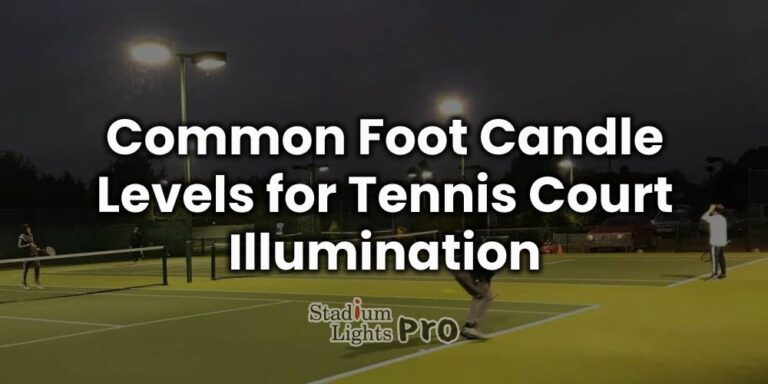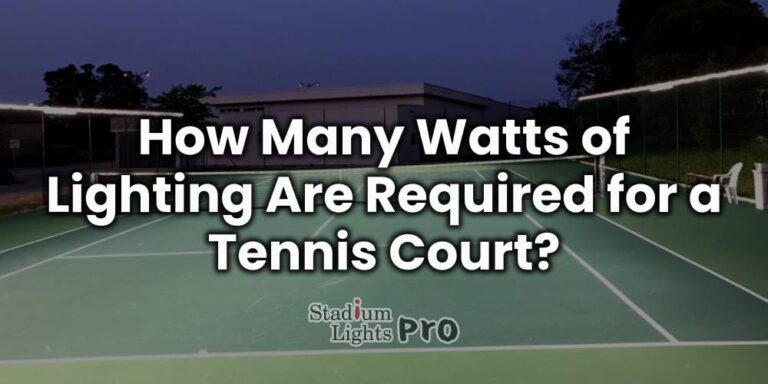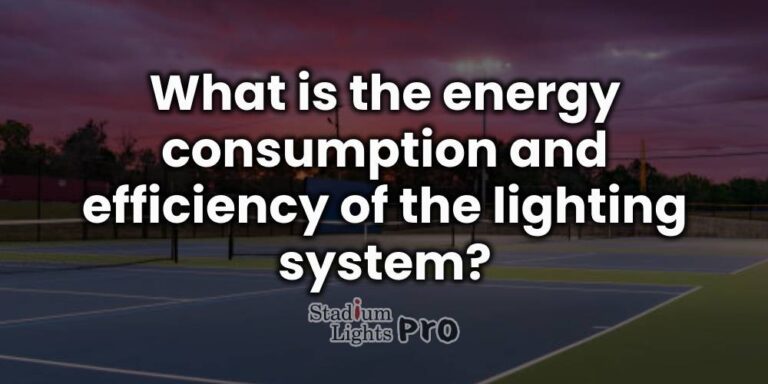
Tennis Court Lighting
This page contains useful information about selecting and installing lights for a tennis court. It is intended for individuals or organizations responsible for maintaining or building a tennis court, such as facilities managers, construction workers, or sports club administrators.
We begin by discussing the importance of proper lighting in a tennis court, highlighting the benefits of good visibility for players and spectators. It then goes on to discuss the various factors that should be considered when selecting lights for a tennis court, including the type of lights, the number of fixtures needed, and the intensity of the light.
In addition, we can find information on how to properly install the lights, including guidelines on placement and wiring. It may also include tips on how to maintain the lights over time, such as cleaning and replacing the lights as needed.
Contact us for a free lighting consultation
Tennis is a popular outdoor sport that is played on a rectangular court. Proper lighting is essential for playing a safe and enjoyable game.
Table of Contents
ToggleTennis court lighting frequently asked questions
How much light is needed for a tennis court?

The recommended illumination level for a tennis court is between 50 and 70 footcandles, depending on the type of surface and the level of play.
What type of lighting is best for a tennis court?
LED lights are generally considered to be the best option for tennis court lighting because they are energy efficient, long-lasting, and provide a high quality of light.
How much does it cost to install tennis court lighting?
The cost of installing tennis court lighting will vary depending on the size of the court, the type of lighting chosen, and any additional features or upgrades. In general, you can expect to pay anywhere from $5,000 to $25,000 for a basic lighting system.
How do you maintain tennis court lighting?
Regular maintenance is essential to ensure that your tennis court lighting system is functioning properly. This may include cleaning and replacing bulbs, checking wiring and connections, and testing the system regularly to ensure it is working properly.
Are there any regulations or standards for tennis court lighting?
Yes, there are several standards and guidelines that must be followed when installing and maintaining tennis court lighting. These may include local building codes, electrical codes, and industry standards set by organizations such as the International Tennis Federation and the US Tennis Association.
Can I install tennis court lighting myself?
While it is technically possible to install tennis court lighting yourself, it is highly recommended to work with a professional lighting designer or contractor to ensure that the system is properly designed and installed.
Lighting systems can be complex and require specialized knowledge and equipment, so it is necessary to have the work done by someone who has the necessary expertise and experience.
Can I use solar-powered lighting for a tennis court?

Solar-powered lighting can be a viable option for some tennis courts, depending on the location and size of the court, as well as the available budget and resources.
Solar-powered lighting can be more environmentally friendly and cost-effective, but it may not provide as much illumination as other types of lighting, and it may be less reliable in certain weather conditions. We need to carefully consider the specific needs and constraints of your tennis court when deciding whether solar-powered lighting is a suitable option.
How do I choose the right lighting fixtures for my tennis court?
There are several factors to consider when choosing lighting fixtures for a tennis court, including the size and layout of the court, the type of lighting, the intensity of the lighting, and the budget. It is necessary to work with a professional lighting designer or contractor to ensure that the fixtures are properly sized and positioned for optimal lighting.
Can I upgrade an existing tennis court lighting system?
Yes, it is possible to upgrade an existing tennis court lighting system. This may involve replacing old or damaged fixtures, upgrading to a more efficient or advanced lighting system, or adding additional lights to improve coverage.
What are the best practices for operating and maintaining a tennis court lighting system?
Some best practices for operating and maintaining a tennis court lighting system include: following a regular maintenance schedule, using energy-efficient bulbs and fixtures, checking wiring and connections regularly, and testing the system regularly to ensure it is functioning properly.
Working with a professional lighting designer or contractor can help to ensure that the system is properly maintained and operates at its best.
Can I control the lighting on my tennis court remotely?
Yes, many modern tennis court lighting systems have the ability to be controlled remotely, either through a remote control or via a smartphone app or other device. This can allow you to easily turn the lights on or off, adjust the intensity or color of the lighting, or schedule the lighting to turn on or off at certain times. Remote control capabilities can be a convenient and flexible feature that can help you to better manage and maintain your lighting system.
Can I add features like timers or dimming to my tennis court lighting system?
Yes, many lighting systems for tennis courts have the ability to be equipped with timers or dimming controls. Timers can allow you to schedule the lighting to turn on or off at certain times, which can be convenient and energy efficient.
Dimming controls can allow you to adjust the intensity of the lighting to suit your specific needs or preferences. These features can be added to an existing lighting system or included in a new installation.
Can I add colored lighting to my tennis court?
Yes, it is possible to add colored lighting to a tennis court. This can be done using special LED lights or filters that can change the color of the lighting. Colored lighting can be used for a variety of purposes, such as creating a festive or festive atmosphere, highlighting certain areas of the court, or creating a visual effect.
Can I use natural light for a tennis court?
While natural light can be used to supplement a tennis court lighting system, it is generally not sufficient on its own to provide adequate illumination for safe and enjoyable play.
Natural light can vary in intensity and quality depending on the time of day, the weather, and other factors, so we need to have a reliable and consistent lighting system in place to ensure consistent lighting conditions.
Can I use my tennis court lighting system for other activities or events?
Yes, many tennis court lighting systems are versatile and can be used for other activities or events in addition to tennis. For example, the lighting system may be used for other sports or recreational activities, such as basketball or pickleball.
The lighting system may also be used for special events, such as concerts, festivals, or parties.
Can I install lighting on a grass or clay tennis court?
Yes, it is possible to install lighting on a grass or clay tennis court. However, the specific requirements and considerations for lighting a grass or clay court may differ from those for a hard court.
For example, the lighting system may need to be designed and installed in a way that minimizes the impact on the surface of the court.
Can I use LED lights for a tennis court with a synthetic surface?
Yes, LED lights can generally be used for a tennis court with a synthetic surface. LED lights are a popular choice for tennis courts because they are energy efficient, long-lasting, and provide a high quality of light. However, we need to consider the specific needs and constraints of the court when choosing the type of lighting to use, and to ensure that the lighting system is compatible with the surface of the court.
Can I use a tennis court lighting system indoors?
Yes, it is possible to use a tennis court lighting system indoors. However, the specific requirements and considerations for lighting an indoor tennis court may differ from those for an outdoor court.
For example, the lighting system may need to be designed and installed in a way that takes into account the size and layout of the indoor space, as well as any structural or electrical constraints.
Why is lighting essential for tennis courts?
- Tennis courts need to be well-lit for players to be able to see the ball and each other clearly.
- Poor lighting can lead to accidents and injuries due to players being unable to see the ball or their surroundings.
- Adequate lighting also helps to improve the overall playing experience by allowing players to better track the ball and make more accurate shots.
Factors to consider when designing tennis court lighting
The size and layout of the court
The size of the court will determine the number and placement of lights needed to adequately illuminate the entire playing area.
The layout of the court, including the location of any obstacles or structures, will also impact the placement and angle of the lights.
The type of lighting

There are several types of lighting options available, including incandescent, fluorescent, and LED lights. Each type has its own advantages and disadvantages, so it is necessary to choose the best option for your specific needs.
LED
LED (light-emitting diode) lighting systems are increasingly popular for use in tennis courts due to their energy efficiency, long lifespan, and low maintenance requirements. LED lights use a semiconductor to produce light, and they are known for their ability to generate high levels of light output while consuming relatively little electricity. They also have a longer lifespan compared to other types of lighting systems, which means they may need to be replaced less frequently.
However, LED lighting systems can be more expensive upfront compared to other types of lighting systems, such as metal halide or high-pressure sodium. They may also require specialized fixtures and wiring, which can add to the cost of the project. Additionally, some people may find the color temperature of LED lights to be less warm or less flattering compared to other types of lighting.
Metal Halide
Metal halide lamps are known for their high luminous efficiency, which means that they produce a lot of light for the amount of electricity they use. They are also relatively affordable compared to other types of lighting systems.
Yet, metal halide lamps have some drawbacks that may make them less suitable for some applications. For example, they take some time to warm up and reach full brightness, which can be an issue if the lights need to be turned on and off frequently. They also tend to generate a lot of heat, which can be a concern in some locations. Additionally, metal halide lamps have a shorter lifespan compared to other types of lighting systems, such as LED, which means they may need to be replaced more frequently.
It’s essential to carefully consider the pros and cons of metal halide lighting when deciding whether it is the right choice for your tennis court. Other factors to consider may include the level of lighting needed, the desired color temperature of the light, the required lifespan of the fixtures, and the cost of operating and maintaining the system. Consult with a lighting professional or a tennis court construction company to get more information on the different options and to help determine the best lighting system for tennis court.
High pressure sodium
High pressure sodium (HPS) lamps are known for their high luminous efficacy, which means that they produce a lot of light for the amount of electricity they use. They are also relatively affordable compared to other types of lighting systems.
Nevertheless, HPS lamps have some negative aspects that may make them less suitable for some applications. For example, they have a shorter lifespan compared to other types of lighting systems, such as LED, which means they may need to be replaced more frequently. They also tend to produce a yellowish light that may not be as pleasing to the eye as other types of lighting. Additionally, HPS lamps generate a lot of heat, which can be a concern in some locations.
Fluorescent
Although fluorescent lights are less common than other types of lighting systems such as metal halide or LED. Fluorescent lights use a gas-discharge process to produce light, and they are known for their energy efficiency and relatively low cost.
However, fluorescent lighting systems have some disadvantages. For example, they tend to have a lower luminous efficiency compared to other types of lighting systems, which means they may not produce as much light for the amount of electricity they use. They also tend to produce a colder or more blue-ish light that may not be as pleasing to the eye as other types of lighting. Additionally, fluorescent lights may require specialized fixtures and wiring, which can add to the cost of the project.
The height of the lighting fixtures
The height of the fixtures should be high enough to provide sufficient illumination without causing shadows or glare.
If the fixtures are too low, they may create shadows on the court that can interfere with play. If they are too high, they may create glare that can be distracting or uncomfortable for players.
The ideal height will depend on the size and layout of the court, as well as the intensity of the lighting. It is recommended to work with a professional lighting designer or contractor to ensure that the fixtures are properly positioned and angled for optimal lighting.
The intensity of the lighting
The intensity of the lighting should be sufficient to allow players to see the ball clearly, but not so bright that it causes discomfort or distractions. If the lighting is too dim, players may have difficulty seeing the ball or each other, which can lead to accidents and injuries. If the lighting is too bright, it can cause discomfort or distractions for players, which can negatively impact the overall playing experience.
The ideal intensity will depend on the size and layout of the court, as well as the height and type of lighting fixtures used.
Installation and maintenance
We should work with a professional lighting designer or contractor to ensure that the lighting system is installed correctly and meets all safety and performance standards. This may include choosing the appropriate fixtures, wiring, and controls, as well as following all applicable codes and guidelines.
Regular maintenance is also essential to ensure that the lighting system is functioning properly and to extend its lifespan. This may include cleaning and replacing bulbs, checking wiring and connections, and testing the system regularly to ensure it is working properly.
Conclusion
Tennis court lighting is a critical factor in creating a safe and enjoyable playing environment. Careful consideration of the various factors involved in lighting design and installation will help to ensure a successful outcome.


















